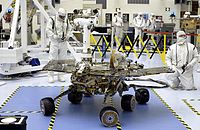
Photo from wikipedia
This paper presents the techniques and results of landing-site topographic mapping and rover localization using orbital, descent and rover images in the Chang’e-4 mission. High-resolution maps of the landing site… Click to show full abstract
This paper presents the techniques and results of landing-site topographic mapping and rover localization using orbital, descent and rover images in the Chang’e-4 mission. High-resolution maps of the landing site are generated from orbital and descent images. Local digital elevation models and digital orthophoto maps with 0.02 m resolution are generated at each waypoint. The location of the lander is determined as (177.588° E, 45.457° S) using festure-matching techniques. The cross-site visual localization method is routinely used to localize the rover at each waypoint to reduce error accumulation from wheel slippage and IMU drift in dead reckoning. After the first five lunar days, the rover travels 186.66 m from the lander, according to the cross-site visual localization. The developed methods and results have been directly utilized to support the mission’s operations. The maps and localization information are also valuable for supporting multiple scientific explorations of the landing site.
Journal Title: Science China Information Sciences
Year Published: 2020
Link to full text (if available)
Share on Social Media: Sign Up to like & get
recommendations!